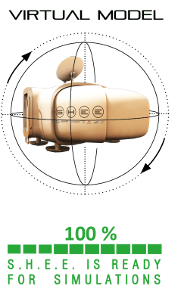 |
 |
 |
 |
 |
 |
 |
The goal of the SHEE project (Self-deployable Habitat for Extreme Environments) is to develop a planetary habitat testbed for terrestrial analogue simulations. The SHEE habitat will provide significant background for further development and evolution of extra-terrestrial habitable structures.
To integrate human labour into construction on the lunar or Martian surface is very risky, complex and costly. To mitigate drawbacks of human construction activity it is an imperative to apply autonomous construction methods. Therefore, self-deployable autonomous habitats are needed in particular in extreme environments without infrastructure and heavy machinery. Such habitats will mitigate construction safety risks and reduce costs. Thus the SHEE also provides a feasible solution for near term human space exploration.
The main objective of the SHEE project is the exploration of an effective integration of architecture and robotics for space applications. SHEE is envisioned to be a hybrid structure system composed of inflatable, rigid and robotic components. The final product will take the form of an example of a functional habitat for further testing and development corresponding to an analogue testing habitat.
The results of the SHEE project will be applicable in both space and terrestrial conditions, such as in extreme environments on earth or during disaster mitigation. This project will also draw attention to possibilities of using space technologies and space design methods in terrestrial domains and in the development of environmentally-friendly architectures.
For more information about this project, click on the letters of the acronym below or read about the project background.
To integrate human labour into construction on the lunar or Martian surface is very risky, complex and costly. To mitigate drawbacks of human construction activity it is an imperative to apply autonomous construction methods. Therefore, self-deployable autonomous habitats are needed in particular in extreme environments without infrastructure and heavy machinery. Such habitats will mitigate construction safety risks and reduce costs. Thus the SHEE also provides a feasible solution for near term human space exploration.
The main objective of the SHEE project is the exploration of an effective integration of architecture and robotics for space applications. SHEE is envisioned to be a hybrid structure system composed of inflatable, rigid and robotic components. The final product will take the form of an example of a functional habitat for further testing and development corresponding to an analogue testing habitat.
The results of the SHEE project will be applicable in both space and terrestrial conditions, such as in extreme environments on earth or during disaster mitigation. This project will also draw attention to possibilities of using space technologies and space design methods in terrestrial domains and in the development of environmentally-friendly architectures.
For more information about this project, click on the letters of the acronym below or read about the project background.
   
|

